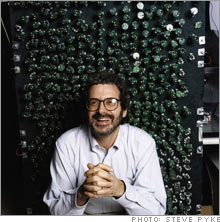A factory of one's ownAccording to MIT's Neil Gershenfeld, the digital revolution is over, and the good guys won. The next big change will be about manufacturing. Anyone with a PC will be able to build anything just by hitting 'print.'(Fortune Magazine) -- Imagine a machine with the ability to manufacture anything. Now imagine that machine in your living room. What would you build first? Would you start a business? Would you ever buy anything retail again? According to MIT physicist Neil Gershenfeld, it's not too early to think about these questions, because that machine, which he calls a personal fabricator, is not so far off - or so far-fetched - as you might think. Gershenfeld is director of MIT's Center for Bits and Atoms (CBA), an interdisciplinary outfit studying the intersection between information theory and industrial design. He also teaches a course called How to Make (Almost) Anything.
Five years ago the National Science Foundation awarded the CBA $14 million to build a manufacturing lab full of futuristic hardware. That includes a nanobeam writer that can etch microscopic patterns on metal, and a supersonic waterjet cutter that generates 60,000 pounds of water pressure, enough to shear through almost any material. The CBA factory can churn out anything, from the tiniest semiconductor to an entire building. Gershenfeld formed the class to introduce his students to the machinery and give them an opportunity he had always craved himself. "In high school I desperately wanted to go to trade school, where we could weld and fix cars," says Gershenfeld, whose fast-talking manner and bobbing head of unruly curls give him the classic aura of a frazzled professor. "People said, 'Because you're smart, you'll have to go to the other school.' I could never figure out why. Now, every semester, students are begging to get in." His students have invented both serious and whimsical creations, from a $10 computer to an alarm clock you have to wrestle to prove you're awake. Like computing before it, Gershenfeld says, this kind of personal manufacturing is coming into the home. He doesn't mean designing a product on a PC and sending the plans off to a plant in China. He means you'll have a setup right in your house. The all-in-one of the future Today your all-in-one device prints, scans, faxes and copies. Tomorrow it will cut, score, etch and sew. Want a new dining room chair? You'll design it on a PC and press PRINT, and your personal fabricator will create it for you right before your eyes. Just make sure tray No. 2 has enough wood. If all that sounds like the kind of techno-utopian idea that often comes out of MIT's Media Lab, there's a reason: The CBA is affiliated with the Media Lab. Gershenfeld, though, says he has history on his side. Digital technology radically transforms industries. Today's laptops are far more powerful than yesterday's mainframes. The last generation's rotary phones are anemic ancestors of our Treos and Black-Berrys. "You don't need [home manufacturing] for what you can get in Wal-Mart," Gershenfeld says. "You need it for what makes you unique." An early manifestation of this idea can be seen in inexpensive clones of CBA's manufacturing lab called Fab Labs. With roughly $40,000 worth of hardware and materials - PCs, open-source CAD/CAM software, networked laser-beam writers, saws, routers, sewing machines - a Fab Lab can do much of what CBA can. "Forty thousand dollars lets you work to microns and microseconds, which is good enough to make a lot of modern technology," Gershenfeld says. The first Fab Lab opened in a Boston housing project. The CBA wanted a place where kids could actually invent. "We said, 'Instead of telling people what we're doing, how about we give people the tools and let them do it?' " Gershenfeld recalls. Today there are 15 labs around the globe, from Ghana, where an 8-year-old girl made a working circuit board, to Norway, where a 14-year-old boy crafted a robot car. "The killer app for personal fabrication in the developed world is technology for a market of one. For the rest of the planet, it's about people developing solutions to local problems," Gershenfeld says. The road from a Fab Lab to a personal fabricator in your living room faces two large hurdles: technology and finance. Gershenfeld is unconcerned about the former. He can see the technological roadmap; we should be there in 20 years, he says. The bigger problem is funding, which is why he's scouting for visionaries in venture capital and microfinance who see the potential. No one has jumped aboard yet, but there is a budding interest. "In the shorter term, the opportunity is in 'Gee, I like that bike, but let me tweak it and make it something different,' " says Michael Angst, a VC with Bluefin Partners. He notes that the do-it-yourself movement embodied in things like Make magazine and Web sites for sharing plans points to a growing market. At some point, Angst says, he'll invest: "A year ago I would have said, 'This is just an MIT project.' But now I'd say, 'There's an emerging community in personal workgroup fabrication.' " Until the money comes, the CBA will continue bootstrapping the movement and deal with the constant stream of requests for help setting up Fab Labs. "Personal expression touches a passion unlike anything I've seen in technology for a very long time. Just about every day we get e-mails saying, 'We want a Fab Lab,' " Gershenfeld says. "The harder e-mails to deal with are the ones that say, 'I'm devoting my life to you and this. Where should I report?' " ___________________________ |
|

